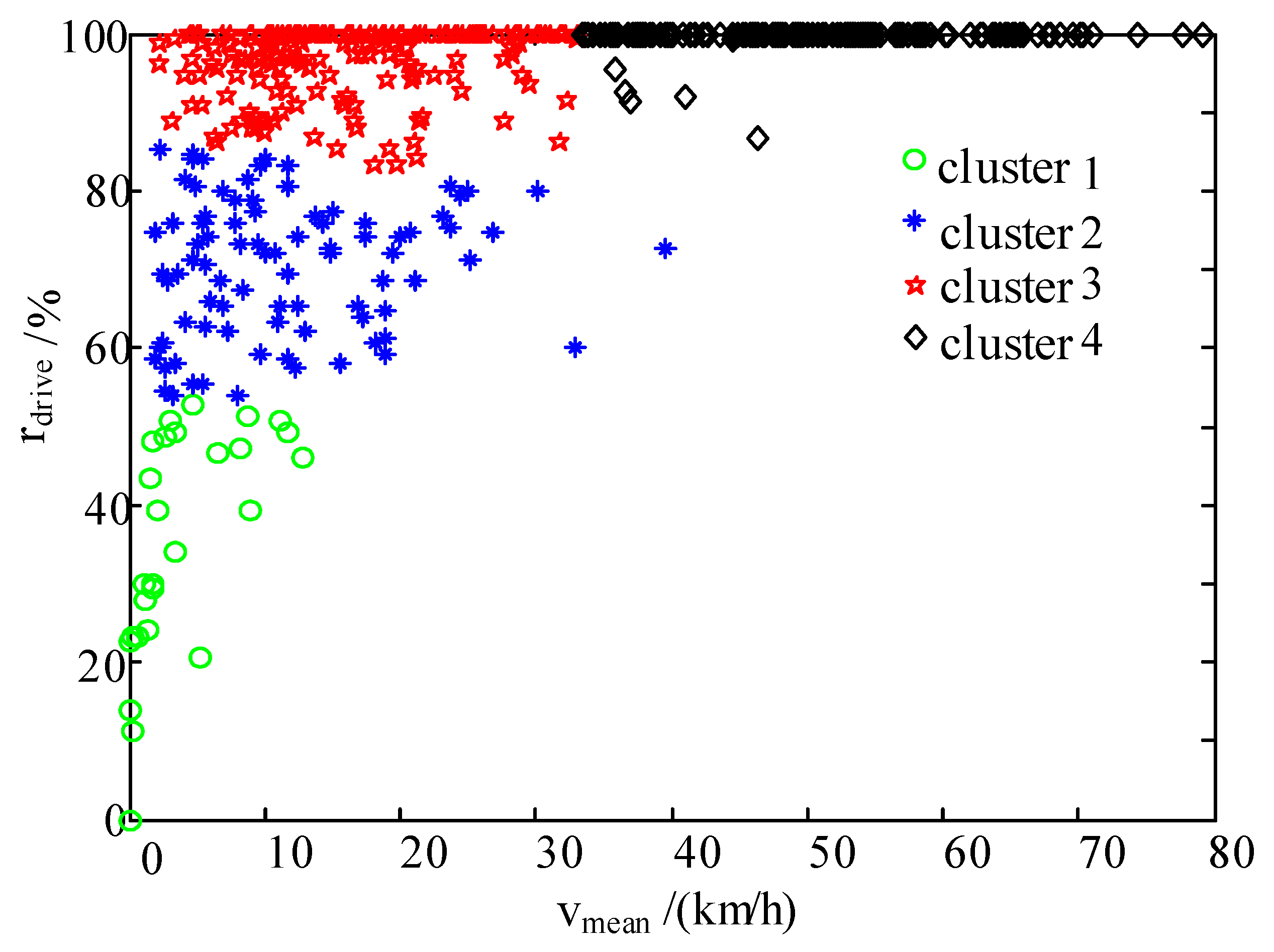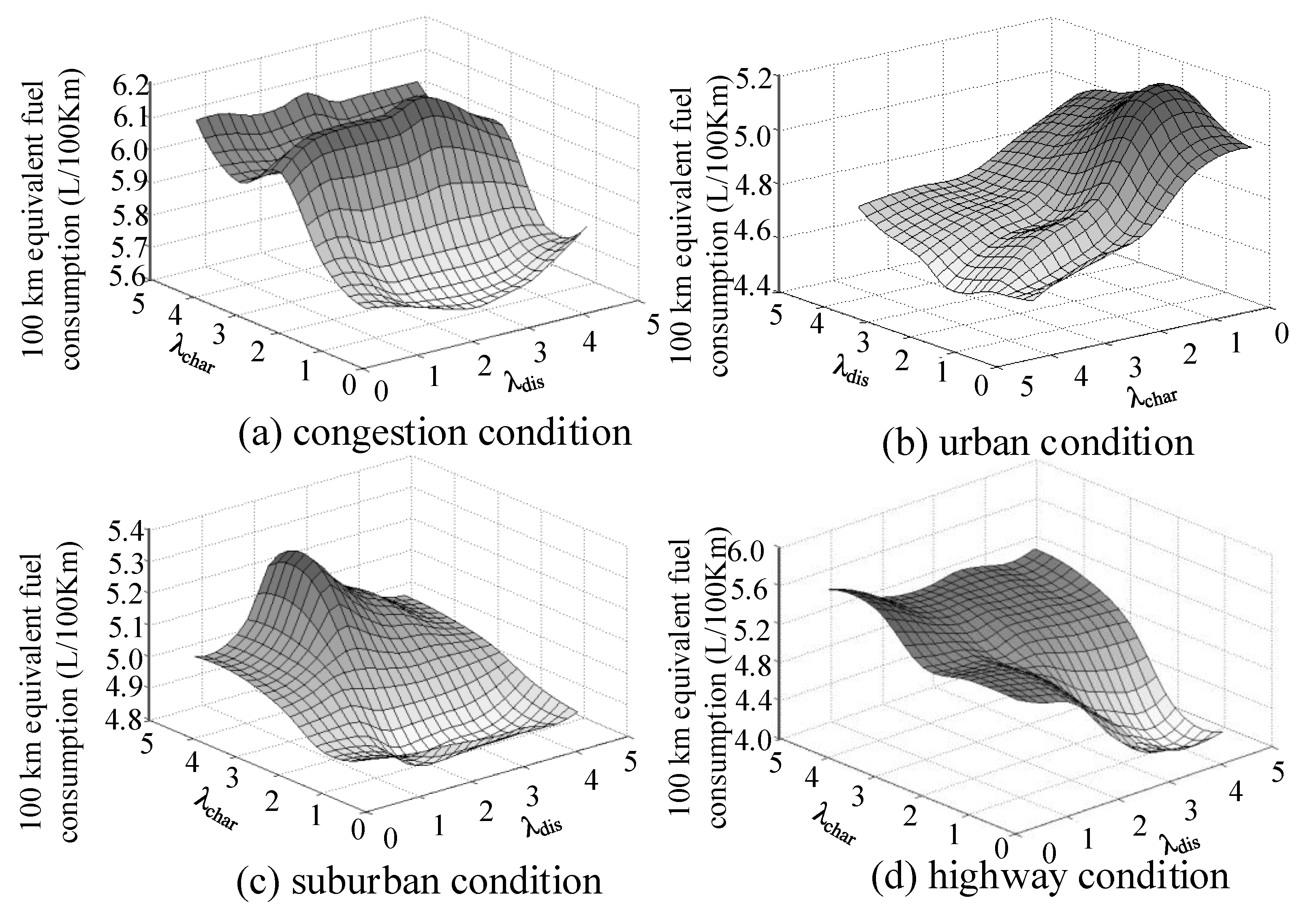Energy Management Strategy for Hybrid Electric Vehicle Based on Driving Condition Identification Using KGA-Means
Abstract
:1. Introduction
2. HEV Power Transmission System Structure and Parameters
3. Optimization of Driving Condition Identification Characteristic Parameters
3.1. Selection of Four Typical Driving Conditions
3.2. Selection and Pretreatment of Basic Driving Condition Data
3.3. Optimization of Characteristic Parameters
4. Energy Management Strategy Based on Driving Condition Identification Using KGA-Means
4.1. Genetic Optimization of K-Means Clustering Center for Driving Condition Identification
4.2. Driving Driving Condition Identification Algorithm Based on KGA-Means
4.3. Optimal Distribution of Demanded Power under Typical Cycle Driving Conditions
4.3.1. ECMS
4.3.2. Estimation of Optimal Fuel Equivalent Coefficient in Four Typical Cycle Driving Conditions
4.3.3. Optimal Distribution of Demanded Power under Four Typical Driving Conditions
5. Materials and Methods
6. Conclusions
- The experimental data is divided into driving condition segments, and the characteristic parameters of these driving condition segments are extracted. The correlation between characteristic parameters, the correlation between fuel consumption and characteristic parameters, and the sensitivity of characteristic parameters to driving conditions are carefully investigated. On this basis, the characteristic parameters of driving conditions are optimized, and vmean and rdrive are selected as the representative characteristic parameters.
- The K-means clustering algorithm is employed to identify driving conditions, and this identification method is combined with the ECMS to form a novel energy management strategy for HEVs.
- An HEV simulation model is established using MATLAB/Simulink. The simulation results show that using the proposed energy management strategy, the engine operating points are kept closer to the best efficiency curve, while the battery SOC changes more smoothly, and is maintained in a higher efficiency zone. As a result, the overall fuel consumption is reduced by 6.84%.
Author Contributions
Funding
Conflicts of Interest
References
- Sun, C.; He, H.; Sun, F. The Role of Velocity Forecasting in Adaptive-ECMS for Hybrid Electric Vehicles. Energy Procedia 2015, 75, 1907–1912. [Google Scholar] [CrossRef]
- Wang, J.; Wang, Q.N.; Zeng, X.H.; Wang, P.Y.; Wang, J.N. Driving cycle recognition neural network algorithm based on the sliding time window for hybrid electric vehicles. Int. J. Automot. Technol. 2015, 16, 685–695. [Google Scholar] [CrossRef]
- Zheng, C.; Xu, G.; Zhou, Y. Realization of PMP-based power management strategy for hybrid vehicles based on MPC scheme. In Proceedings of the IEEE International Conference on Information Science and Technology, Shenzhen, China, 26–28 April 2014; pp. 682–685. [Google Scholar]
- Guardiola, C.; Pla, B.; Reig, A. Modelling driving behavior and its impact on the energy management problem in hybrid electric vehicles. Int. J. Comput. Math. 2014, 91, 147–156. [Google Scholar] [CrossRef]
- Musardo, C.; Rizzoni, G.; Guezennec, Y.; Staccia, B. A-ECMS: An Adaptive Algorithm for Hybrid Electric Vehicle Energy Management. Decis. Control 2006, 11, 509–524. [Google Scholar]
- Datong, Q; Zhiyuan, P.; Yonggang, L.; Zhihui, D.; Yang, Y. Dynamic Energy Management Strategy of Hybrid Electric Vehicle Based on Driving condition Identification. China Mech. Eng. 2014, 25, 1550–1555. [Google Scholar]
- Guanlong, Y. Research on Energy Management Strategy of Plug-in Hybrid Vehicle Based on Driving Intention and Driving Condition Identification; Chongqing University: Chongqing, China, 2014. [Google Scholar]
- Zhuang, J.; Du, A.A. An Analysis on Quick Start of Engine in ISG HEV. Automot. Eng. 2008, 30, 305–308. [Google Scholar]
- Gurkaynak, Y.; Khaligh, A.; Emadi, A. Neural adaptive control strategy for hybrid electric vehicles with parallel powertrain. In Proceedings of the Vehicle Power and Propulsion Conference, Chicago, IL, USA, 6–9 September 2011. [Google Scholar]
- Huang, X.; Tan, Y.; He, X. An intelligent multi-feature statistical approach for discrimination of driving driving conditions of hybrid electric vehicle. In Proceedings of the International Joint Conference on Neural Networks, Atlanta, GA, USA, 14–19 June 2009. [Google Scholar]
- Guopeng, L. Control Strategy for Hybrid Buses Based on Road Driving Conditions and Load Status Identification; Tsinghua University: Beijing, China, 2011. [Google Scholar]
- Jeon, S.I.; Jo, S.T.; Lee, J.M. Multimode Driving Control of a Parallel Hybrid Electric Vehicle Using Driving Pattern Recognition. J. Dyn. Syst. Meas. Control. 2002, 124, 489–494. [Google Scholar] [CrossRef]
- Hongfei, H.; Xiangdong, H.; Yutao, L. HEV Real-time Equivalent Energy Consumption Minimum Control Strategy. Automot. Eng. 2006, 28, 516–520. [Google Scholar]
- Guohui, C.; Congbo, H. Research on the calculation method of automobile economy based on binary interpolation algorithm. Agric. Equip. Veh. Eng. 2012, 50, 26–28. [Google Scholar]
- Yiyou, L. Research on Power Balance Energy Management Control Strategy for Hybrid Hybrid Buses; Chongqing University: Chongqing, China, 2011. [Google Scholar]

















| Parameter | Value | |
|---|---|---|
| Vehicle | Vehicle mass (kg) | 1547 |
| Windward area A (m2) | 2.28 | |
| Drag coefficient CD | 0.357 | |
| Wheel radius r (m) | 0.289 | |
| Rolling resistance coefficient fr | 0.0083 | |
| Engine | Maximum power (kW) | 85.1 |
| Maximum torque (Nm) | 160 | |
| ISG | Maximum power (kW) | 32 |
| Maximum torque (Nm) | 113 | |
| Battery | Capacity Q0 (Ah) | 40.5 |
| Nominal voltage U0(V) | 360 | |
| Initial SOC | 0.65 | |
| CVT | Speed ratio range iCVT | 0.422~2.432 |
| Main reduction ratio i0 | 5.297 | |
| Rcor | vmean | vmax | amean | ridel | rdrive | … | s | vvar | vspa | aspa |
|---|---|---|---|---|---|---|---|---|---|---|
| vmean | 1.00 | 0.92 | 0.018 | −0.52 | 0.52 | … | 1 | 0.28 | 0.97 | 0.13 |
| vmax | 0.92 | 1.00 | −0.036 | −0.45 | 0.45 | … | 0.92 | 0.56 | 0.87 | 0.31 |
| amean | 0.018 | −0.036 | 1.00 | 0.0037 | −0.0037 | … | 0.011 | −0.17 | −0.049 | −0.060 |
| ameana | −0.026 | 0.14 | 0.18 | 0.098 | −0.098 | … | −0.026 | 0.26 | −0.065 | 0.84 |
| ameand | −0.12 | −0.28 | 0.16 | −0.035 | 0.035 | … | −0.12 | −0.39 | −0.069 | −0.87 |
| ridel | −0.52 | −0.45 | 0.037 | 1.00 | −1.00 | … | −0.52 | −0.063 | −0.41 | −0.010 |
| rdrive | 0.52 | 0.45 | −0.037 | −1.00 | 1.00 | … | 0.52 | −0.063 | −0.41 | −0.010 |
| amax | −0.18 | −0.056 | 0.073 | 0.22 | −0.22 | … | −0.18 | 0.19 | −0.19 | 0.70 |
| amin | −0.077 | −0.19 | 0.075 | −0.58 | 0.82 | … | −0.077 | −0.27 | −0.053 | −0.73 |
| s | 1 | 0.92 | 0.011 | −0.026 | −0.12 | … | 1.00 | 0.28 | 0.97 | 0.13 |
| vvar | 0.29 | 0.56 | −0.17 | −0.063 | 0.063 | 0.28 | 1.00 | 0.25 | 0.41 | |
| avar | 0.13 | 0.30 | −0.058 | −0.10 | 0.10 | … | 0.13 | 0.41 | 0.069 | 0.99 |
| vspa | 0.97 | 0.87 | −0.0049 | −0.41 | 0.41 | 0.97 | 0.25 | 1.00 | 0.071 | |
| aspa | 0.13 | 0.31 | −0.060 | −0.10 | 0.10 | … | 0.13 | 0.41 | 0.072 | 1.00 |
| Rcor | vmean | vmax | amean | ameana | ameand | ridel | rdrive |
| Traditional vehicle fuel consumption | 0.915 | 0.838 | 0.162 | 0.109 | −0.170 | −0.386 | 0.386 |
| HEV fuel consumption | 0.957 | 0.894 | 0.144 | 0.145 | −0.238 | −0.475 | 0.475 |
| Rcor | amax | amin | s | vvar | avar | vspa | aspa |
| Traditional vehicle fuel consumption | −0.0691 | −0.1521 | 0.914 | 0.243 | 0.200 | 0.942 | 0.202 |
| HEV fuel consumption | −0.0484 | −0.200 | 0.957 | 0.287 | 0.267 | 0.956 | 0.270 |
| Rcor | v mean | vmax | amean | ameana | ameand | ridel | rdrive |
| R1 | 0.334 | 0.318 | 0.688 | 0.116 | 0.210 | 0.269 | 0.269 |
| R2 | 0.859 | 0.772 | 0.956 | 0.260 | 0.478 | 0.551 | 0.551 |
| Rcor | amax | amin | s | vvar | avar | vspa | vspa |
| R1 | 0.112 | 0.193 | 0.334 | 0.214 | 0.180 | 0.293 | 0.180 |
| R2 | 0.288 | 0.491 | 0.859 | 0.363 | 0.362 | 0.680 | 0.364 |
| Driving Condition | λchar Equivalent Fuel Coefficient When Charging | λdis Equivalent Fuel Coefficient When Discharging |
|---|---|---|
| Congestion condition | 1.1 | 3.0 |
| Urban condition | 5.0 | 2.8 |
| Suburban condition | 1.8 | 2.6 |
| Highway condition | 1.5 | 4.5 |
© 2018 by the authors. Licensee MDPI, Basel, Switzerland. This article is an open access article distributed under the terms and conditions of the Creative Commons Attribution (CC BY) license (http://creativecommons.org/licenses/by/4.0/).
Share and Cite
Li, S.; Hu, M.; Gong, C.; Zhan, S.; Qin, D. Energy Management Strategy for Hybrid Electric Vehicle Based on Driving Condition Identification Using KGA-Means. Energies 2018, 11, 1531. https://doi.org/10.3390/en11061531
Li S, Hu M, Gong C, Zhan S, Qin D. Energy Management Strategy for Hybrid Electric Vehicle Based on Driving Condition Identification Using KGA-Means. Energies. 2018; 11(6):1531. https://doi.org/10.3390/en11061531
Chicago/Turabian StyleLi, Shuxian, Minghui Hu, Changchao Gong, Sen Zhan, and Datong Qin. 2018. "Energy Management Strategy for Hybrid Electric Vehicle Based on Driving Condition Identification Using KGA-Means" Energies 11, no. 6: 1531. https://doi.org/10.3390/en11061531




